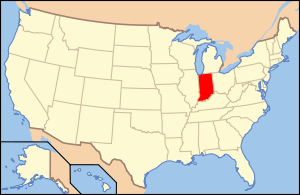Viniculture in Indiana
| Indiana | |
|---|---|

|
|
| Official name: | State of Indiana |
| Appellation type: | State |
| Year of establishment: | 1816 |
| Country: | United States |
| Sub-regions: | Ohio River Valley AVA |
| Recognized cultivation area: | 94,322 km² (36,418 sq mi ) |
| Planted acreage: | 1.09 km² (270 acres ) |
| Grape varieties: | Aurore , Baco Noir , Cabernet Franc , Cabernet Sauvignon , Catawba , Cayuga , Chambourcin , Chardonel , Chardonnay , Concord , Geisenheim , Gewürztraminer , Léon Millot , Maréchal Foch , Merlot , Muscat Canelli , Niagara , Pinot Gris , Pinot Noir , Riesling , Sauvignon Blanc , Seyval Blanc , St. Vincent , Steuben , Traminette , Vidal Blanc , Vignoles , Villard Blanc , Viognier |
Viticulture in Indiana refers to viticulture in the American state of Indiana . Under U.S. law, every state and county is a protected designation of origin and does not need to be recognized as such by the Bureau of Alcohol, Tobacco, Firearms and Explosives .
Due to the early settlement and a wine-growing history since 1816, Indiana was still in the middle of the 19th century in tenth place of the most important growing areas in the United States. As almost everywhere, viticulture came to a standstill as a result of alcohol prohibition . There is currently a single defined American Viticultural Area (AVA for short), the Ohio River Valley AVA .
See also
literature
- André Dominé (Ed.): Wine . Tandem Verlag, Königswinter 2007, ISBN 978-3-8331-4344-1 .
- Bruce Cass, Jancis Robinson : The Oxford Companion to the Wine of North America . Oxford University Press, Oxford et al. 2000, ISBN 0-19-860114-X .
Individual evidence
- ↑ a b Appellation America (2007). "Indiana: Appellation Description" . Last page view on October 20, 2008